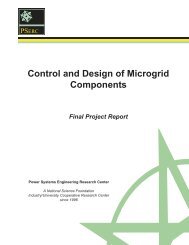Development and Evaluation of System Restoration Strategies from ...
Development and Evaluation of System Restoration Strategies from ...
Development and Evaluation of System Restoration Strategies from ...
Create successful ePaper yourself
Turn your PDF publications into a flip-book with our unique Google optimized e-Paper software.
customized plans for specific system conditions. This form <strong>of</strong> automated (or,<br />
alternatively, semi-automated) tool is expected to run in parallel with the restoration<br />
process, with each run using updated values for loads <strong>and</strong> expected generation in order<br />
for the tool to use the best available information during the entire process.<br />
The computer tool for the operator permissive distribution system automation approach<br />
used optimization algorithms, in particular, the Lagrangian relaxation method <strong>and</strong> Binary<br />
Integer Programming. Using the tool, restoration plans are developed using the objective<br />
<strong>of</strong> minimizing outage cost <strong>and</strong> restoration time for a specified percentage <strong>of</strong> system load<br />
restoration. Other objectives that consider a weighted priority ranking or system security<br />
may also be adopted by replacing the cost function with the pertinent objective function.<br />
Due to the dual characteristics <strong>of</strong> the Lagrangian relaxation method, global convergence<br />
is not guaranteed as some constraints may be ignored during the optimization problem. In<br />
addition, the total accuracy <strong>of</strong> the solution will also depend on the estimates used for load<br />
<strong>and</strong> expected available generation. Matlab codes for the Distribution <strong>System</strong> <strong>Restoration</strong><br />
Module are given in the report.<br />
The developed algorithms were tested on 4-feeder <strong>and</strong> 100-feeder test systems under<br />
several blackout scenarios. The results showed that automated restoration is practical for<br />
small <strong>and</strong> modest size systems (e.g., to at least 100 feeders <strong>and</strong> 25 substations). The tool<br />
is expected to reduce restoration times significantly. The number <strong>of</strong> hours per year<br />
required for restoration depends on the specific nature <strong>of</strong> the given distribution system.<br />
However, a system with system average interruption duration <strong>of</strong> three hours per year, for<br />
example, could be reduced to two hours per year. Networked distribution systems have<br />
the potential for dramatic reduction in system average interruption duration per year (e.g.,<br />
by an order <strong>of</strong> magnitude).<br />
Future work related to the distribution system restoration problem will enhance the<br />
models used in the tool to fully represent a practical restoration plan for a distribution<br />
system. Some needs for future development include:<br />
• Further modeling <strong>of</strong> the cold load pick up phenomena<br />
• <strong>Evaluation</strong> <strong>of</strong> the impact <strong>of</strong> phase sequence in capacitor switching<br />
• <strong>Evaluation</strong> <strong>of</strong> the effect <strong>of</strong> system transmission <strong>and</strong> system voltage pr<strong>of</strong>ile<br />
constraints in the distribution system restoration problem<br />
• Determination <strong>of</strong> the role <strong>and</strong> c<strong>and</strong>idacy <strong>of</strong> this tool as part <strong>of</strong> smart grid<br />
initiatives<br />
• <strong>Development</strong> <strong>of</strong> demonstration projects for automated restoration<br />
• Additional system configurations <strong>and</strong> various system constraints.<br />
iv
















